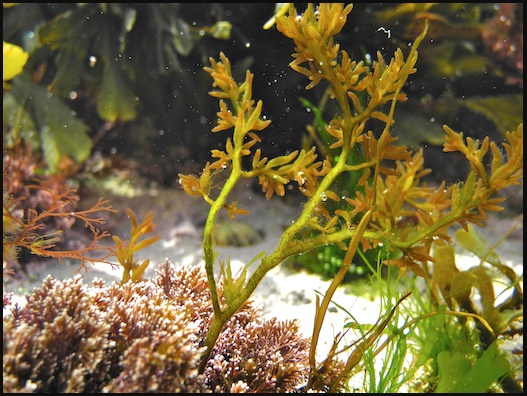Chapter: Aquaculture Principles and Practices: Seaweeds
Seaweeds

Seaweeds
Though aquaculture as practised today is largely based on vertebrate and
invertebrate animal species, plants contribute a substantial proportion of
world production through aquatic farming. Seaweed agriculture production in
1999 was estimated at 9.5 million tons (wet weight), which was about 22 per
cent of that year’s overall aquaculture production (FAO, 2001). The bulk of
this production was from China (7284887 tons), followed by the Phillipines
(620620 tons), Korean Republic (473175 tons), Korea DPR (413000 tons), Vietnam
(18200 tons), Malaysia (11847 tons) and the rest of the countries (119496 tons).
In the major producing countries, namely Japan, China and Korea,
seaweeds are grown mainly for human consumption. Seaweeds are also used as
fodder and in the manufacture of agar, carrageenan, alginates, mannitol and
iodine. China now produces on a commercial scale analogue foods such as
‘shredded jellyfish’ from seaweeds. Many other countries, including the USA,
Canada and some Carribbean Islands, are now undertaking experimental and
pilotscale culture to produce raw material for industrial uses. Small-scale
farming of fresh-water aquatic plants like the water chestnut (Trapa spp.), water cress (Nasturtium spp.) and water spinach (Ipomoea spp.) has been under-taken by
Asian farmers for many centuries, but large-scale farming of aquatic plants has
only been done in the marine environment. It originated in Japan about three
centuries ago with the culture of ‘nori’ or the laver (Porphyra spp.), which continues to be the most important species
cultivated for human consumption.
Seaweed culture, particularly of Laminaria,
has advanced rapidly in China.

Doubts have been expressed about the value of seaweeds in human
nutrition. Their use as a condiment or vegetable is limited to oriental
countries and among certain ethnic groups else-where.Though the total per
capita consumption is not very high, its protein content is not low (35.6 per
cent in dried nori, Bardach et al.,
1972). The amino acid composition is reported to be 10–30 per cent of the dry
weight, and thecontents of vitamins A, B1, B2, B6, B12, C and niacin are very high. In addition, these edible seaweeds have
higher contents of the important minerals calcium and iron than vegetables and
fruits (Fujiwara-Arasaki et al.,
1984). Irrespective of the direct nutritional value, seaweeds have an important
role in the overall food consumption of the people and therefore obviously in
their nutrition. An unsatisfied demand for good-quality seaweed products for
food, additives for food products and other industrial uses provided the
rationale for the increased interest in introducing or expanding seaweed
culture in several countries. The main groups of seaweeds cultivated for human
food are the following:
Red algae (Rhodophyceae)
Porphyra spp.
Gracilaria spp.
Brown algae (Phaeophyceae)
Undaria pinnatifida
Laminaria spp.
Green algae (Chlorophyceae)
Enteromorpha compressa
Monostroma spp.
All are typically marine species, but there are differences between
species in their salinity and temperature tolerance. Many of them cannot
withstand exposure to wide variations in salinity. Many of the edible seaweeds
require lower temperatures, between 10 and 20°C, for rapid growth. They are
largely intertidal and subtidal species, and the lower limits of vertical distribution
are governed by the levels of light intensity. Reproduction can be both sexual
and asexual. Some species of red algae exhibit a biphasic (gametophyte,
carposporophyte) type of alternation of generation, while others are triphasic
(gametophyte, carposporophyte, tetrasporophyte). The discovery of the
micro-scopic conchocelis phase in Porphyra
spp. has been a landmark in the understanding of the summer phase of the
reproductory cycle of these seaweeds. Asexual reproduction by means of asexual
(neutral) spores occurs in the rather young stage of the leafy plants and this
often accounts for the heavy settlement on collectors in culture operations.
Vegetative propagation is also common among most of the cultivated species.
Gracilaria spp., favoured as agarophytes, arebeing widely cultivated in several
Asian countries, notably China, the Phillipines and Vietnam (FAO/NACA, 1996).
Chile has begun Gracilaria cultivation
on a large scale lately andrecent production as high as 120000 tons has been
reported (Buschmann et al., 2001).
Integrated farming of Gracilaria
along with prawns (FAO/NACA, 1996) and with salmonids in cages (Troell et al., 1997) has also been reported.
The latter has some ecological advantages because seaweeds make use of the
nutrients N and P and organic matter released by the aquatic animals, leading
to sustainable farming systems.
Related Topics